When I went vegan nearly 8 years ago I was committed to never missing out on the flavors, textures, sensations, and pleasure I so enjoyed while eating the traditional dishes I’d grown up with. So much of our food is based on tradition, memories from childhood, fun times with friends and family, and gatherings we crave and enjoy.
It’s understandable that people don’t want to give up these simple pleasures and neither should they have to. That is why I got so excited when tasting the dish I’m sharing the recipe for with you today… it hits all the buttons!
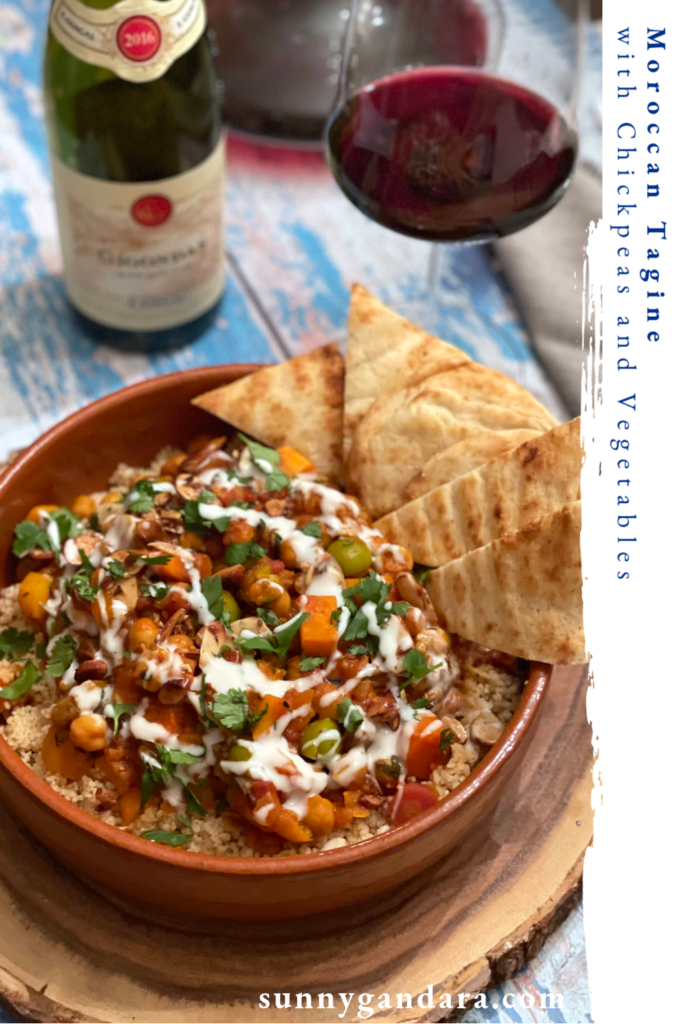
One of the first trips I took with my parents as a young girl was at the age of 11 when we went to Tunisia. I was mesmerized by the explosion of flavors I experienced eating the many couscous-based dishes, it was so different from the subtle, well let’s put it more honestly: mild, spice-free Norwegian diet I had grown up with. It lit a fire in me and a desire to seek out new ingredients and dishes while vowing to travel the world to see what other countries had to offer.
Tunisian food is different than Moroccan food of course (Morocco was actually the first foreign trip I ever took… inside my mom’s belly 🙂 However, it opened up my eyes to explore North African cuisine and all its exciting dishes.
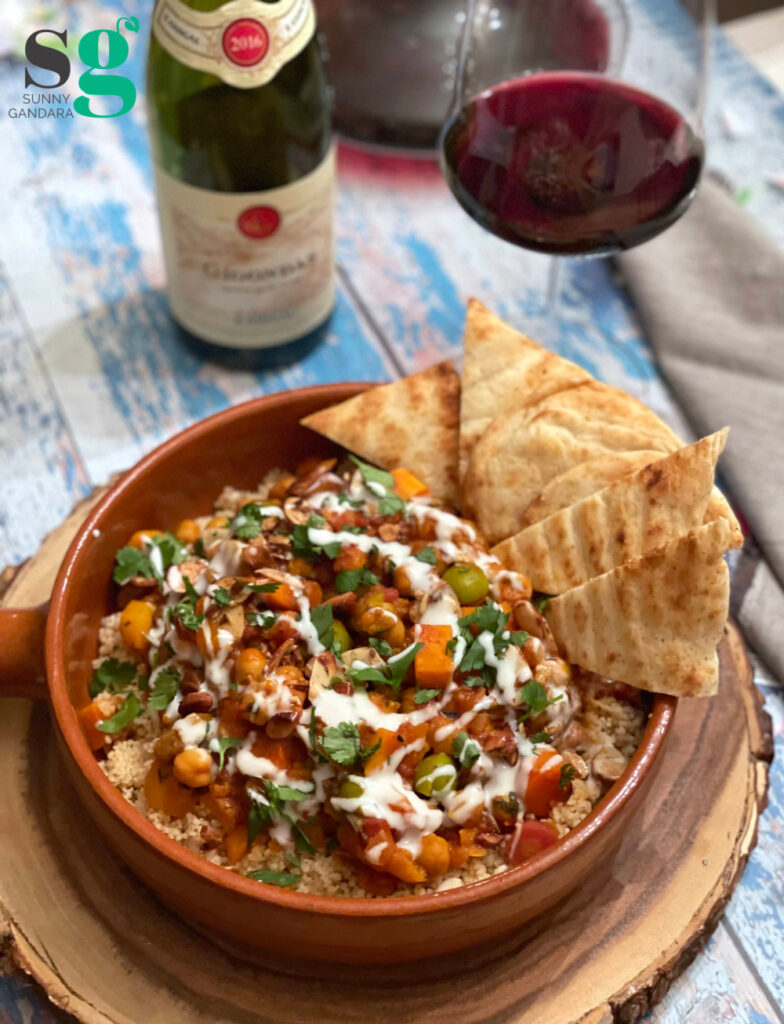
Today I’m sharing with you a super flavorful Morrocan tagine filled with chickpeas, sweet potatoes, and carrots, along with dried apricots, golden raisins, and green olives, topped with a cashew yogurt, butter toasted sliced almonds, and freshly chopped cilantro. Served with pita bread and a glass of southern Rhone Valley wine based on the Grenache grape… I can tell you, I’ve been able to travel virtually and rekindled my desire to visit the countries of North Africa once again.
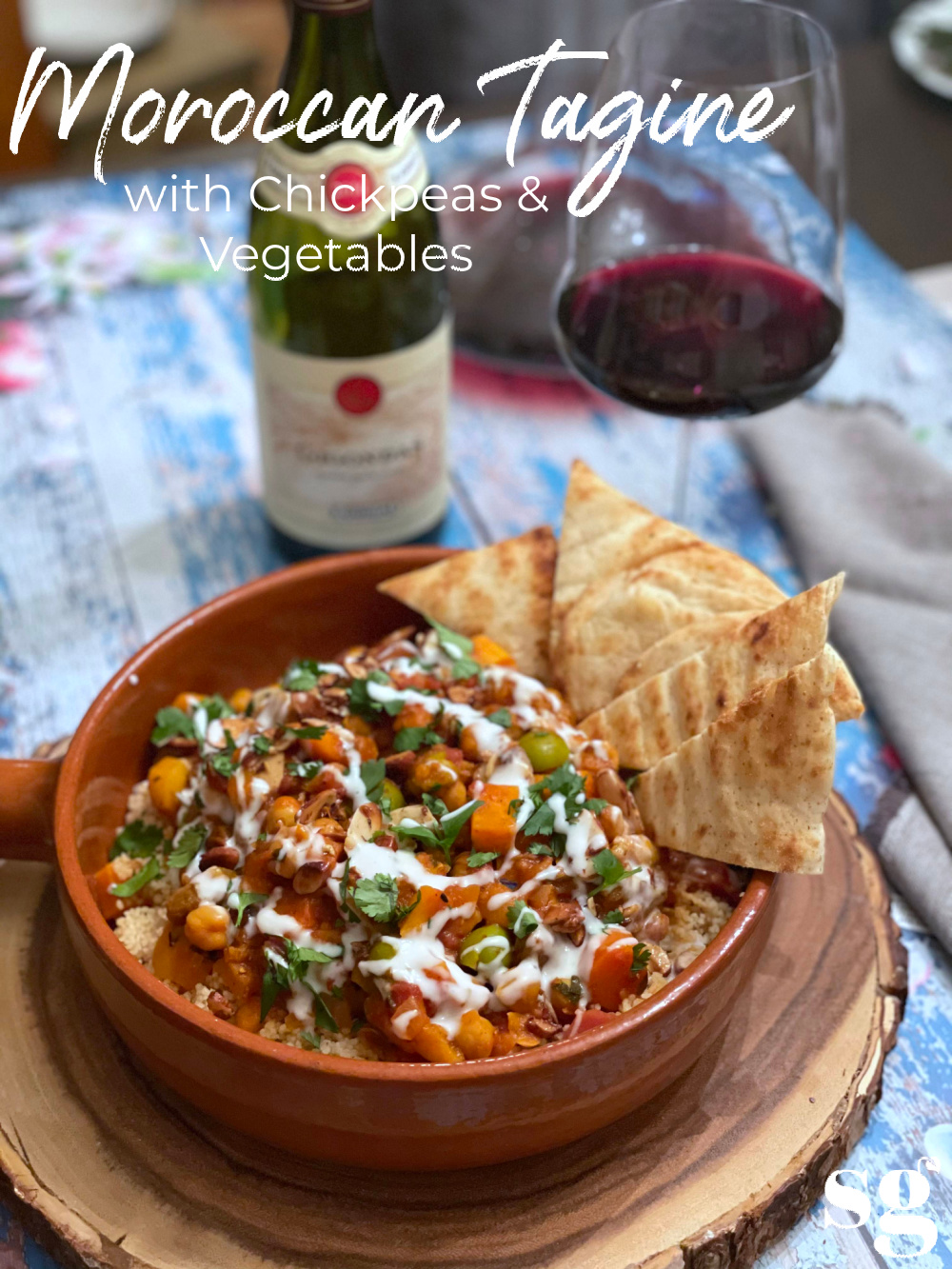
A couple of notes:
Ras el’ Hanout is a spice mix found in varying forms in Tunisia, Algeria, and Morocco. The mixture usually consists of over a dozen spices, in different proportions. Commonly used ingredients include cardamom, cumin, clove, cinnamon, nutmeg, mace, allspice, dry ginger, chili peppers, coriander seed, peppercorn, sweet and hot paprika, fenugreek, and dry turmeric.
It plays a similar role in North African cuisine as garam masala does in Indian cuisine.
You can find it in most specialty shops or you can order it online from one of my all-time favorite shops, Kalustyans.
Harissa paste is a hot chili paste that originated in Tunisia. This versatile red condiment is sold in tubes and is a blend of different hot chiles combined with garlic, olive oil, tomatoes, and spices like cumin, caraway, and mint.
You might think “why bother” getting these ingredients only for this recipe. But the beauty of both ras el’ hanout and harissa is that you can use them for a variety of dishes to enhance flavors and they will keep forever.
Take a step out of your comfort zone and get these two specialty items then watch your culinary repertoire grow!!
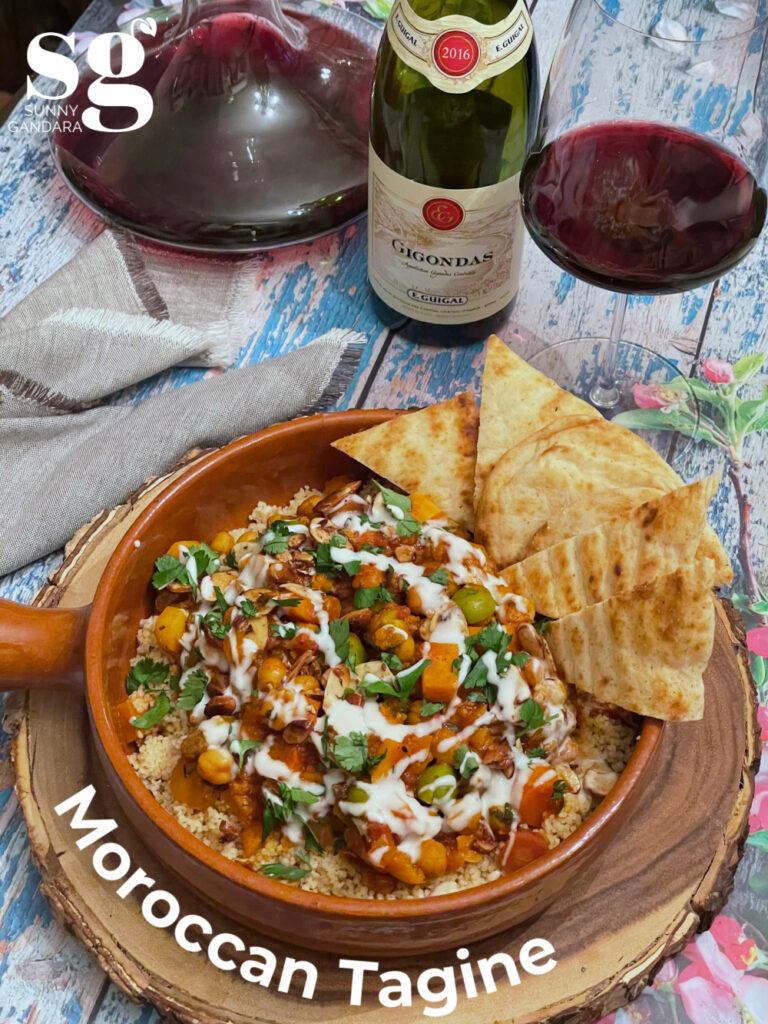
Wine Pairing:
For this dish, I chose Guigal’s 2016 Gigondas, a wine from the southern Rhone by this mega-producer and a blend of 70% Grenache, 20% Syrah, and 10% Mourvedre. It is aged in oak foudres for 2 years, 50% of which is new.
This is a full-bodied wine with floral and smoky aromas, plush red fruit on the palate, coupled with earthiness, bright acidity, and firm tannins, and the traditional dusty tannins many wines from this region possess. The 2016 vintage was brilliant in the southern Rhone and gave the wines a fresh racy style and one that can definitely be aged for years to come.
Guigal is a world-known and lauded producer, who produces wines of exceptional quality and sets the benchmark for every appellation of this region, both in the north and the south of the Rhone Valley. Known more for their excellent Chateauneuf-du-Pape in the south, they also know northern Rhone like nobody else, especially Cote Rotie.
No pesticides, herbicides, or chemicals are used in the vineyards, and the fact that some of Guigal vines date back to the 1890s is a testimony to the nurturing, obsessive approach the Guigals have in their vineyards.
If you can’t find their Gigondas, I also recommend their Cote du Rhone, which is a more serious example of this genre and aged for 36 months before release and a great value at around $17. Their Gigondas is approximately $28, depending on where you are in the world.
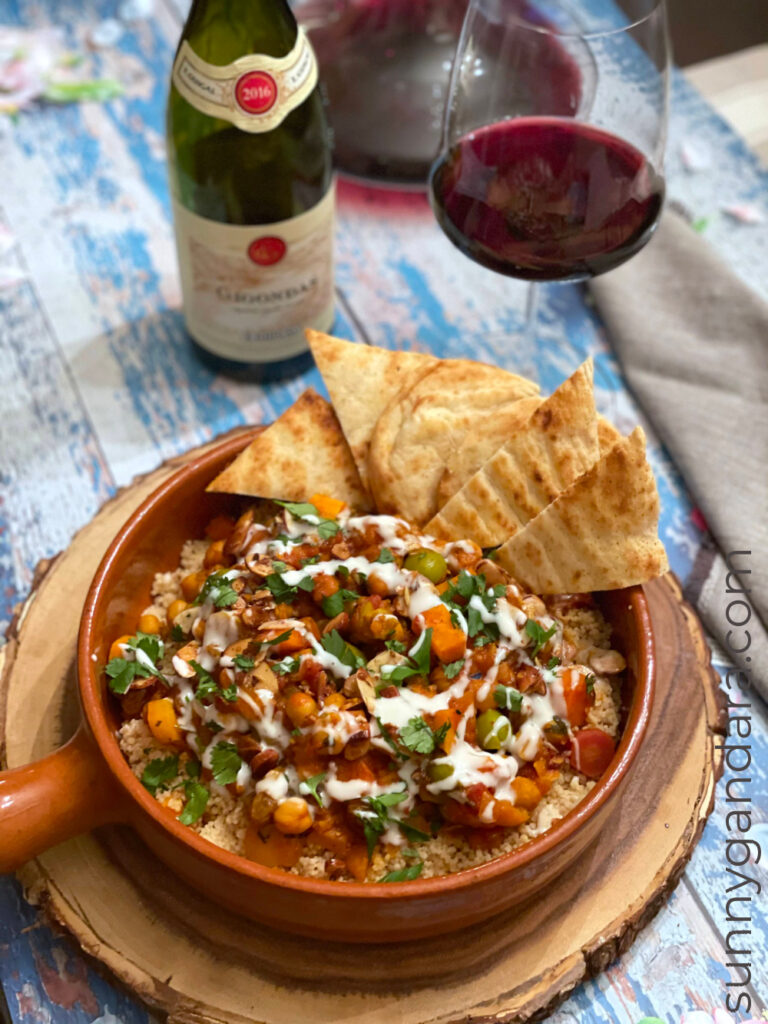
The generous ripe red fruit is a great match for the sweetness in the tagine provided by the dried fruit and the sweet potatoes, and the earthiness in the wine mimics the earthiness in the whole wheat couscous. The bright acidity brings out the brininess in the olives and helps cut through the yogurt drizzled on top. There is also herbaceousness in the wine which comes out when tasting the cilantro in the dish.
All around, this is a hearty dish that stands up well to the muscular, yet elegant wine. Try it out and let me know what you think!
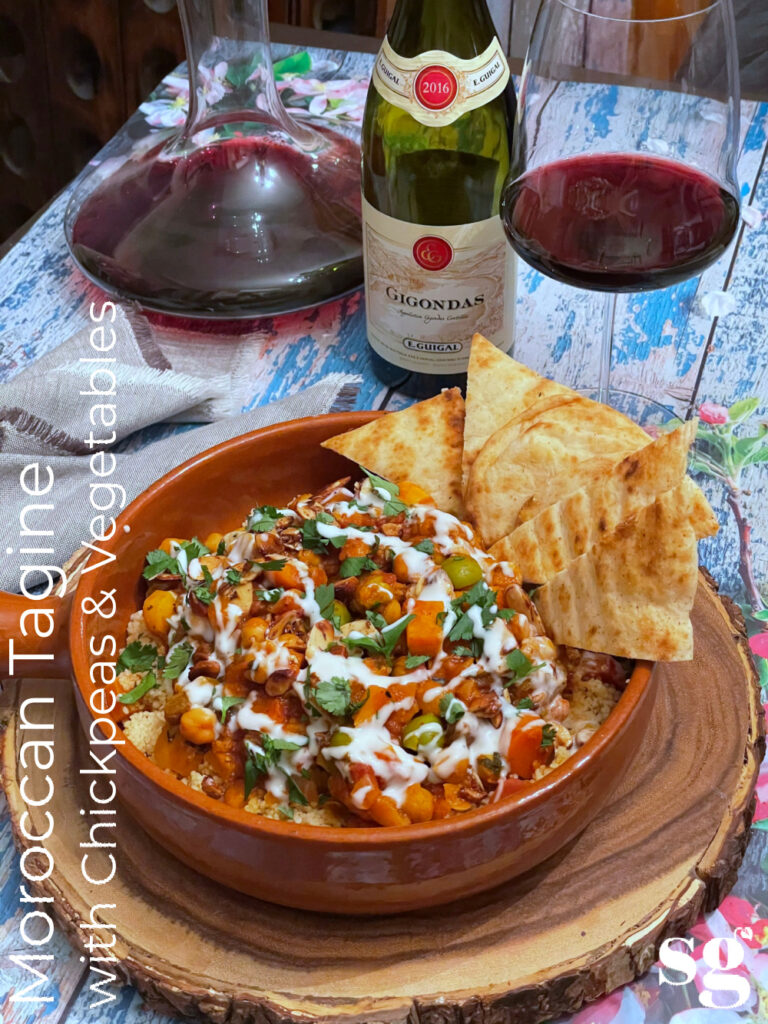
MOROCCAN TAGINE WITH CHICKPEAS AND VEGETABLES
Serves 6
2 -3 tbsp olive oil
1 sweet onion, diced fine
3 garlic cloves, peeled and minced
1 inch (2.5 cm) fresh ginger, minced
1 tbsp coriander seeds, lightly toasted in a dry skillet and ground up
1 tbsp cumin seeds, lightly toasted in a dry skillet and ground up
2 tsp ground cinnamon
1 tbsp Ras el’ Hanout
2 tsps ground turmeric
1 pinch saffron (optional but great to add for flavor)
salt and pepper to taste
1-2 tbsp harissa paste (sub tomato paste if you don’t have harissa)
2 medium sweet potatoes, peeled and diced
2 large carrots, peeled and diced
1/2 cup (85 g) dried apricots, roughly chopped (golden raisins work well too)
1/2 cup (85 g) golden raisins
3 cups (7 dl) vegetable stock/broth
1 x 28 oz (794 g) can organic chopped tomatoes
2 x 15 oz (500 ml) organic canned chickpeas, drained and rinsed
2 tbsp maple syrup
1 cup (2.5 dl) green olives (I used Castelvetro), pitted and halved (optional)
zest and juice from 1 lemon
a couple of handfuls of fresh cilantro, chopped plus more for garnish
Sliced almonds, lightly sautéed in butter until golden, for garnish
1 ½ cup (3.5 dl) whole wheat organic couscous
1 ½ cup (3.5 dl) vegetable broth, hot
1 tablespoon olive oil
To prepare couscous:
Place couscous in a medium bowl with a pinch of salt, pour over 1 ½ cups boiling vegetable broth, add in the olive oil and stir quickly with a fork to combine. Cover the bowl with a plate or plastic wrap. Let sit for 10-15 minutes for the liquid to be absorbed.
Fluff up with a fork and set aside until ready to serve.
To prepare tagine:
In a heavy-duty large pot, add a few drops of good olive oil, add the onions, garlic and ginger and a good sprinkle of salt, sauté for a few minutes, then add the spices and sauté for another minute, stirring continuously.
Add carrots and sweet potatoes with a large pinch of salt, as well as the harissa paste, and coat all the vegetables with the paste.
Then add vegetable stock, canned tomatoes, chickpeas, apricots, and golden raisins. Bring to a boil, reduce to a simmer, cook for about 20-30 minutes until vegetables are tender and the stew has thickened.
Finally, add the olives, lemon juice and zest and maple syrup as well as the fresh chopped cilantro. Cook for another 5 minutes, taste for seasoning.
Serve over warm couscous and garnish with additional cilantro, sliced almonds and a lemon wedge.
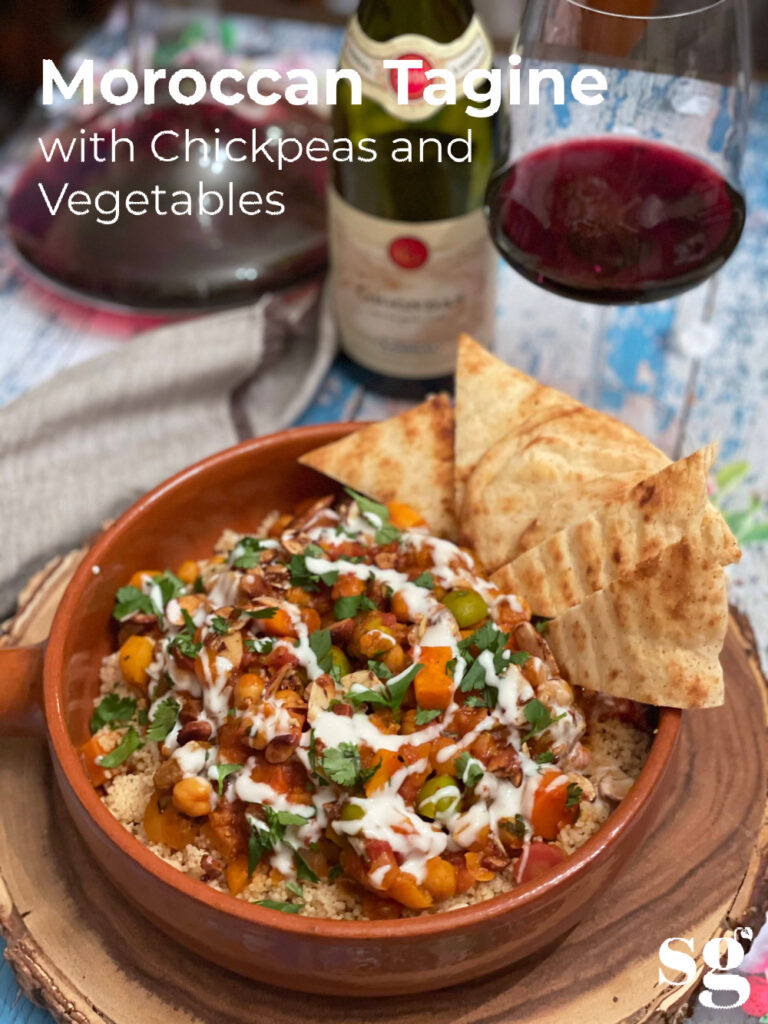
More Recipes To Try…
A Flavorful Falafel Plate with Tahini Sauce and Tzatziki
Cold Peanut-Sesame Noodles with Tofu
PrintMoroccan Tagine with Chickpeas and Vegetables
This super flavorful Morrocan tagine is filled with chickpeas, sweet potatoes, and carrots, along with dried apricots, golden raisins, and green olives, topped with cashew yogurt, butter toasted sliced almonds, and freshly chopped cilantro. Serve with pita bread.
- Yield: 6 1x
- Category: Main
Ingredients
2 –3 tbsp olive oil
1 sweet onion, diced fine
3 garlic cloves, peeled and minced
1 inch (2.5 cm) fresh ginger, minced
1 tbsp coriander seeds, lightly toasted in a dry skillet and ground up
1 tbsp cumin seeds, lightly toasted in a dry skillet and ground up
2 tsp ground cinnamon
1 tbsp Ras el’ Hanout
2 tsps ground turmeric
1 pinch saffron (optional but great to add for flavor)
salt and pepper to taste
1–2 tbsp harissa paste (sub tomato paste if you don’t have harissa)
2 medium sweet potatoes, peeled and diced
2 large carrots, peeled and diced
1/2 cup (85 g) dried apricots, roughly chopped (golden raisins work well too)
1/2 cup (85 g) golden raisins
3 cups (7 dl) vegetable stock/broth
1 x 28 oz (794 g) can organic chopped tomatoes
2 x 15 oz (500 ml) organic canned chickpeas, drained and rinsed
2 tbsp maple syrup
1 cup (2.5 dl) green olives (I used Castelvetro), pitted and halved (optional)
zest and juice from 1 lemon
a couple of handfuls of fresh cilantro, chopped plus more for garnish
Sliced almonds, lightly sautéed in butter until golden, for garnish
1 ½ cup (3.5 dl) whole wheat organic couscous
1 ½ cup (3.5 dl) vegetable broth, hot
1 tablespoon olive oil
Instructions
To prepare couscous:
Place couscous in a medium bowl with a pinch of salt, pour over 1 ½ cups boiling vegetable broth, add in the olive oil and stir quickly with a fork to combine. Cover the bowl with a plate or plastic wrap. Let sit for 10-15 minutes for the liquid to be absorbed.
Fluff up with a fork and set aside until ready to serve.
To prepare tagine:
In a heavy-duty large pot, add a few drops of good olive oil, add the onions and garlic and a good sprinkle of salt, sauté for a few minutes, then add the spices and saute for another minute, stirring continuously.
Add carrots and sweet potatoes with a large pinch of salt, as well as the harissa paste, and coat all the vegetables with the paste.
Then add vegetable stock, canned tomatoes, chickpeas, apricots, and golden raisins. Bring to a boil, reduce to a simmer, cook for about 20-30 minutes until vegetables are tender and the stew has thickened.
Finally, add the olives, lemon juice, and zest as well as the fresh chopped cilantro. Cook for another 5 minutes, taste for seasoning.
Serve over warm couscous and garnish with additional cilantro and a lemon wedge.
Notes
Ras el’ Hanout is a spice mix found in varying forms in Tunisia, Algeria, and Morocco. The mixture usually consists of over a dozen spices, in different proportions. Commonly used ingredients include cardamom, cumin, clove, cinnamon, nutmeg, mace, allspice, dry ginger, chili peppers, coriander seed, peppercorn, sweet and hot paprika, fenugreek, and dry turmeric.
It plays a similar role in North African cuisine as garam masala does in Indian cuisine. You can find it in most specialty shops or you can order it online from one of my all-time favorite shops, Kalustyans.
Harissa paste is a hot chili paste that originated in Tunisia. This versatile red condiment is sold in tubes and is a blend of different hot chiles combined with garlic, olive oil, tomatoes, and spices like cumin, caraway, and mint.
You might think “why bother” getting these ingredients only for this recipe. But the beauty of both ras el’ hanout and harissa is that you can use them for a variety of dishes to enhance flavors and they will keep forever.




0 Comments